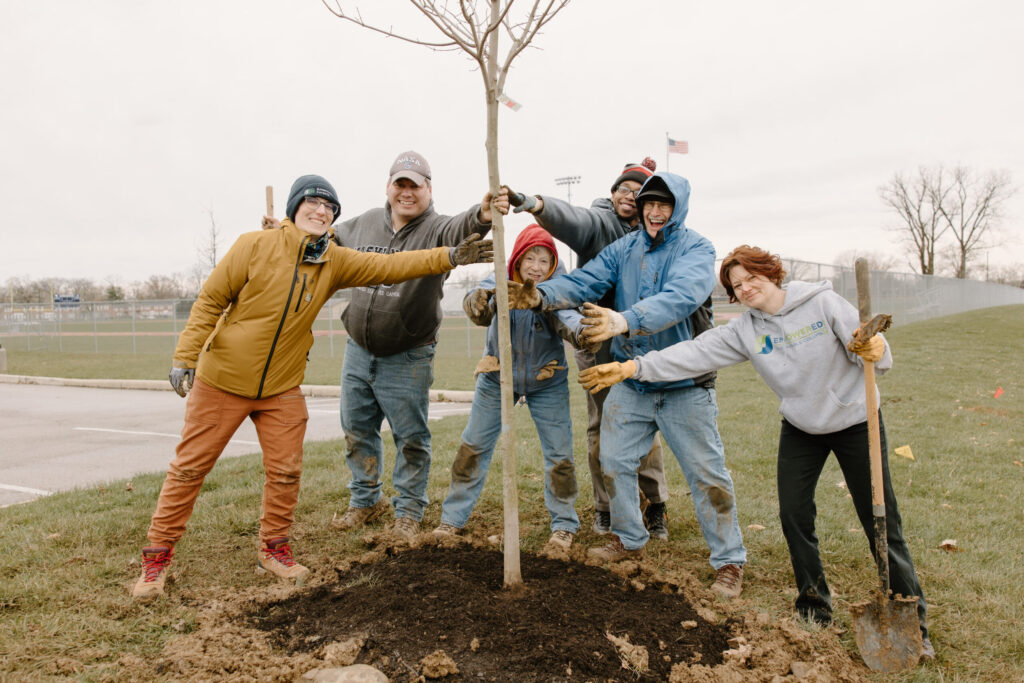American Forests and Green Columbus Partner with Google to Enhance Tree Equity in Central Ohio

|
Listen to this story:
|
Volunteers helped plant 50 trees in an area with one of the lowest Tree Equity Scores in Franklin County, which will help improve the area’s tree canopy in the future
American Forests, the first national nonprofit conservation organization in the U.S., worked alongside Green Columbus to plant 50 trees at Columbus Africentric Early College High School on March 26. This planting follows the launch of American Forests’ Franklin County, OH Tree Equity Score Analyzer application, which Google’s philanthropy, Google.org, supported with $45,000 in funding.
The Census block group containing the planting site currently has a Tree Equity Score of 61, one of the lowest in the surrounding area.
Between 2011 – 2021, Franklin County’s total tree canopy coverage increased 2.8% according to a Tree Canopy Assessment of Columbus and Franklin County. It will take a little more than 4 million trees to get every neighborhood in Franklin County to a Tree Equity Score of 100, an equitable distribution of tree cover across the county.
“This is a pivotal step forward for Franklin County urban forestry,” said Joshua Simon, Senior Manager, Community Engagement at American Forests. “This initiative is not just about planting trees. It’s about laying the groundwork for a greener, more equitable future for our community. By bringing together diverse partners and resources, we’re demonstrating a strong commitment to improving the environmental health and livability of our urban spaces.”
Representatives from Green Columbus, American Forests, Google,Tree Equity Score Analyzer Stakeholder Councilmembers, Columbus community members, and Columbus Africentric were all present at the planting, working with volunteers, including local Google employees, to plant trees that will thrive in the Franklin County environment.
“Our goal is to improve Tree Equity by planting trees in high need communities and involving residents in the process. We are striving to create a culture which cares about trees in Central Ohio to advocate for improved health outcomes, increased heat mitigation, and resilient communities,” said Shelly Douglas, Executive Director of Green Columbus.
American Forests’ Tree Equity Score has long been a recommended tool for Franklin County communities to protect and sustain urban forestry projects. The location was chosen based on the data available in American Forests’ Tree Equity Score Analyzer, which was recently launched for Columbus and Franklin County and works in tandem with American Forests’ Tree Equity Score National Explorer.
The Franklin County TESA Stakeholder Council — a group of locally-based officials, environmental organizations and residents — also provided input on the final planting location. The newly developed Tree Equity Score Analyzer, tailored for Columbus and Franklin County, offers advanced prioritization for tree planting efforts, scenario planning, and impact reporting. This tool is designed to assist users in improving Tree Equity Scores on a site-by-site basis. It supports a community-focused, data-informed strategy for creating practical tree planting and preservation strategies. By doing so, it ensures attention is directed towards the neighborhoods which need more tree canopy.
Related Article: Google Announces Water Stewardship Initiatives for World Water Day
Beyond sponsoring today’s planting, Google.org’s funding supported Green Columbus’ co-leadership of the formation of the Franklin County TESA. Resources were also distributed via stipends to members of the TESA Stakeholder Council.
“When applied correctly, technology has enormous capacity to help drive innovative solutions to tough problems,” said Amber Tillman, Head of Data Center Economic and Community Development for the Eastern US & Canada. “We’ve been proud to support the creation of the TESA and excited to see how the data and insights are used to create greener, more equitable urban spaces across Franklin County.”






